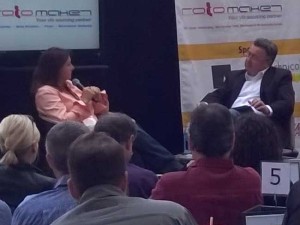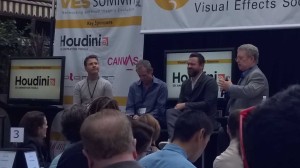
“Time is the enemy. There’s one enemy, and it’s time.” That might sound like a philosophical observation about the swiftness of life, but at this past weekend’s VES Summit – the Visual Effects Society’s annual look at VFX as both an entertainment lynchpin and a career path – it was more specifically about production timetables.
Kicking off this year’s edition at Hollywood’s W Hotel was Victoria Alonso, who has made the journey from visual effects producer to producer for Marvel Studios, most recently with the political thrills of Captain America: The Winter Soldier and the inter-species familial bonding, and digital triumphs of Guardians of the Galaxy, with a new Avengers installment, and more in her future.
Alonso talked about how studio expectations for delivering the impossible expand, but the timetables for delivering finished versions of those expectations don’t. Veering into something that was more like philosophy, she said she’s learned to cherish the variables that always confound the best laid plans… or productions. “I love prepping, knowing nothing will work,” she said, adding that she even loves things like “weather that comes and shuts you down.”
At that point, her microphone actually shut off, which veered more toward metaphysics than philosophy.
But with a new mic in hand, she helped kick off the day’s activities with comments that remained both practical and aspirational.
On the aspirational side, the last few days have seen steady industry buzz around Alonso’s comments on getting more women into VFX. “Where are the girls? You’ve got to get the girls in here, boys. Remember that it’s OK to allow the ladies in. They’re smart. They’re talented. They bring a balance that you need.” She also called for more on screen female superheroes. “If it were up to me, it would be today,” she said about the possibility of greenlighting a femme-led comics property.
Ironically, DC/Warner’s – perceived as being slower out of the starting blocks in assembling its own cinematic hero-verse – has announced a Wonder Woman project, so the gauntlet has been thrown in that regard.
But regardless of the gender mix in the rendering room, or how smart a given studio is about its tentpole releases, Alonso recognized that the “practicalities” for many digital workers – especially those with families – are growing steadily more impractical.
“Some families are being displaced,” she acknowledged, stating that with her producer hat, “if I can make a deal in the U.S., I’ll do it here.”
But a lot resides in that “if” – including studio pressure to contain budgets, and general accounting department disbelief if dangled foreign tax rebates are actually passed over.
Those were some of the themes of the first roundtable we attended. These shouldn’t be confused with the “panels” of VES Summits past, with their front-forward presentations from gathered experts. This was, well, more immersive – a harbinger, perhaps, of where digital entertainment is headed in general.

People gathered at the numbered tables where the tickets they picked at registration lead them – some topics getting sold out early. The format was to gather around, led by a single moderator, and share experiences, prognostications and perhaps contact info and lunch dates, if the networking really paid off.
Our first roundtable was “Freelance: Surviving as a Nomad.” Led by Debra Blanchard Knight, who presides over Fringe Talent, placing digital workers hither and yon, there was much talk about the the digital hiring frenzy currently taking place in Vancouver.
That in turn is driving up rents in that formerly budget-compatible town. Some of the migrant workers at our table noted that that city is no longer any more affordable than L.A. or San Francisco.
One founder of his own Bay-area shop lamented the old days, when he was at ILM and visual effects was an actual job with a fixed place. Summers would often be slow, and people would look for ways to keep busy during such seasons.
Now, of course, slow time at a company means you’re laid off since you weren’t a “staff hire” to begin with, and the thing that keeps you busy is looking for the next gig.
Our post-brunch panel drew the “Animation Domination” card, which sounds like a block of programming that you or your kids might have watched in the ’90s.
Instead – as moderated by Dave Walvoord, VFX supervisor for the latest How to Train Your Dragon 2, among others – the discussion became more about how aspects of animation workflow are everywhere. Which would make sense, since none other than Salman Rushdie opined, around the time of A Perfect Storm’s release, that most movies now were in fact cartoons, if we’re going by the amount of animation in them, even if that animation is photorealistic.
There was some consensus that when a thing is actually called “animation,” rather than a feature film (let alone a tentpole) those similarly constructed pipelines tend to run more efficiently.
There was also talk of how fast all the virtual tools change, regardless of pipeline, things like fluid solvers, and more, leading to upcoming aesthetic challenges: When making cartoons, how real is too real?
And further, when will performances by actors – either deceased or aged beyond their critical character roles in a franchise – be fully, digitally recreated?
The consensus was that “you’re always behind” (think of trying to keep up with the latest cell phone your pocket), or perhaps especially, when called upon to build “three year pipelines” each time a new feature-length project is launched.
But that would, at least, mean work for those people for those three years.
The afternoon ended with everyone training their attention back to the stage. The concluding discussion was a “Visual Imaging” panel, that included Ben Grossmann, a VFX Oscar winner for Hugo, along with DP Dion Beebe (of recent Edge of Tomorrow, and many other fames), and production designer and Cat-in-the-Hat director Bo Welch.
Grossmann said he’d been researching 100 years of film business models to try and figure out how we got to this juncture, and thought it had to do with the fact that visual or special effects was always its own department, mostly working in post, where all the new technology kept getting shoved, so it didn’t disrupt the flow of the established production departments, like cinematography, design and costuming.
But now, he notes, “visual effects is no longer visual effects – it’s production by other means.”
Welch, when asked what he’d most want if he found himself back be in the director’s’ chair, said ideally, all departmental workflows would be simultaneous.
Beebe talked about DIs and color corrections all happening in post, and acknowledged that while he understood productions not keeping a DP on for an extra nine months to contribute to that process, how could the person in charge of light, not be involved? Perhaps a consulting role, for post, could become part of the deal.
When asked by an audience member about ways all these evolving skill sets could, in fact, be brought into production workflow at the same time, rather than being stuck in rigid pre, on-set and post, designations, Grossmann opined that a “Holodeck” was all that was needed.
That would allow for each artisan to move around a virtual recreation of the film in real time, tending to each aspect of production.
“We’ve done good work here,” he happily concluded.





